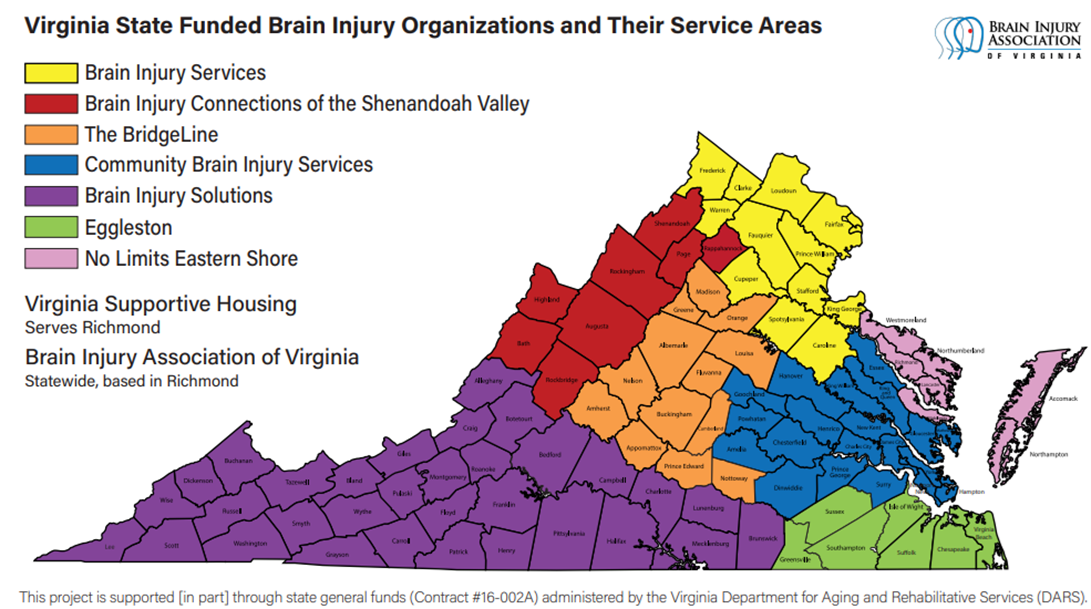The Department for Aging and Rehabilitative Services recognizes that deficits in non-vocational life areas may adversely affect the ability of a person with a brain injury to gain and/or maintain employment.
Community providers throughout the State are partially funded by the Department for Aging and Rehabilitative Services through State General Funds to provide Community Support Services. These services involve intensive one-to-one education and training to assist a person with a brain injury to live and participate as independently as possible in home, work, and community settings of their choice. Funded providers submit quarterly reports of how they are serving providers with brain injury in the following areas:

To find information on the program nearest you, select the area or name of the program from the list below.
The Outcome for Independent Living is for Individuals to have the ability for independent living and obtain self-management skills in order to live with the least level of support on a daily basis. Independent Living is the ability to carry out basic activities of Daily Living (ADLs)such as[bathing, dressing, toileting, grooming, and feeding] and perform Instrumental Activities of Daily Living (IADLs) [managing personal health care issues; shopping and meal preparation, performing household tasks such as laundry and cleaning, handling financial affairs, and driving and/or arranging transportation].
The goals of Independent Living are to:
Main Office:
Department for Aging and Rehabilitative Services
8004 Franklin Farms Drive
Richmond, Virginia 23229
(804) 662 -7000
The importance of Productive Activity is to engage individuals in all types of activities in the community. Productive Activity is an individual’s contribution to the community. Productive Activities may include employment, education, volunteerism, or other meaningful activities. These goals are developed to engage individuals in activities that productively engage him/her into community activities.
Following are goals that allow individuals to:
The impact of residential settings is to provide individuals the ability to live in the least restrictive housing option of their choice, while ensuring that they are safe and stable. These options are places where an individual has services and supports, so they can live as independently as possible. This can range from 24-hour supervision to on-call assistance. These services will allow an individual to feel more inclusive in their community.
Behavioral health services involve identifying and treating mental health disorders such as depression or anxiety, as well as intervening in individual behaviors that negatively affect overall health and functioning. Behavioral health services assist people to continue working or attending school, engage with their families, and to participate as desired in community activities and events. Ultimately, the goals of behavioral health services are to help people function optimally so they can lead healthier, fuller, more independent lives.
Following are the goals that allow individuals to improve their residential settings:
Community Impact includes activities conducted by brain injury services providers in the areas of Education, Outreach, Public Awareness, and Advocacy that result in the development or enhancement of services for survivors of brain injury. These activities can include the participation of clients and members, as appropriate. Community Impact also includes the assessment, planning, identification and facilitation of activities that help a community to provide specialized services to people with brain injury.
All state-funded brain injury services providers are contractually required to provide at least 3 Community Impact activities per quarter. Their Scorecard score indicates whether they have met or not met that goal.
(revised from Social / Emotional / Behavioral Health)
"Behavioral health" describes the connection and interaction between an individual’s physical and mental health, and how these can affect day to day behavior. Behavioral health goals assist in identifying and intervening in, or ameliorating, behaviors that may negatively affect a person’s ability to function effectively. For example, untreated mental health disorders such as anxiety, depression, or Post Traumatic Stress Disorder (PTSD) can impede the goal of living a healthy, independent, satisfying life. Other behaviors, such as misuse of alcohol / other substances, poor eating habits, or lack of regular health care, may be obstacles to achieving gainful employment, attending school, engaging fully with family and friends, and participating in community activities.
Behavioral health also includes broader factors such as living with high levels of chronic stress due to a change in life circumstances (e.g., changes in finances, housing, declining health of family members). Ultimately, personal goals under the life domain of Behavioral Health should focus on assisting someone to lead a healthier, more independent life.
The following are examples of goals that would be appropriate under Behavioral Health:
The individual: